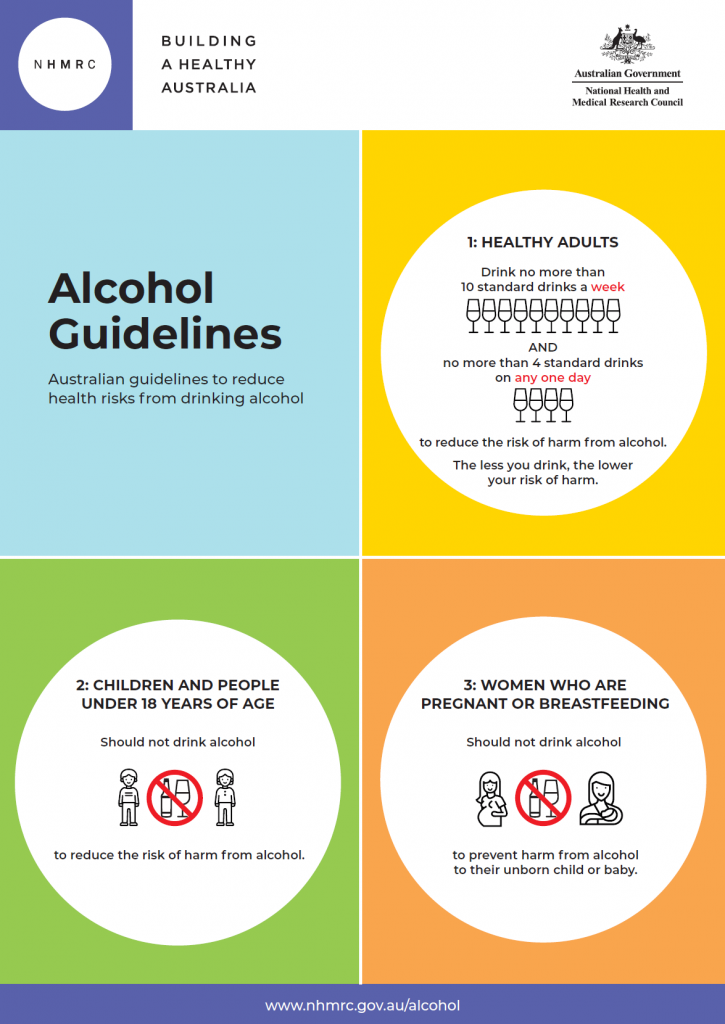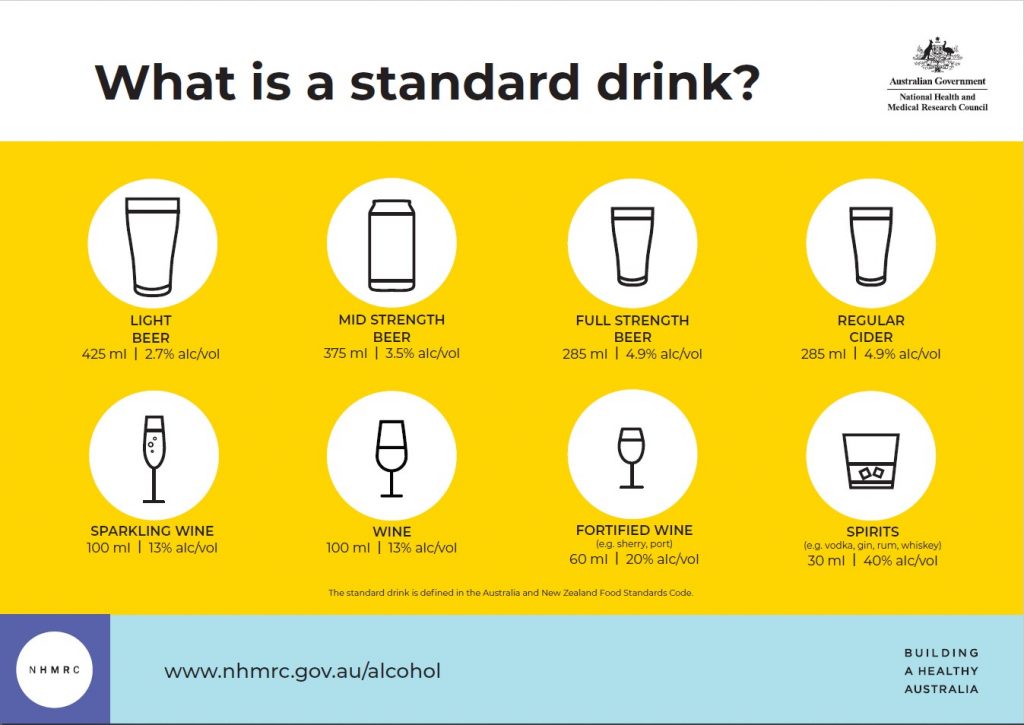Alcohol
Alcohol is produced by the fermentation of a wide variety of plants including grains, vegetables and fruit. Spirits are produced by further distilling the products of fermentation to concentrate the alcohol. In its pure form alcohol is a colourless liquid with an intense taste and a burning effect. Alcoholic drinks vary in colour, taste and aroma depending on what is in them and how they are made.
People drink alcohol for a variety of social, cultural and religious reasons, with meals, to celebrate, to relax and to socialise.
The Effects
Alcohol consumption is rapidly absorbed into the bloodstream and its effects on the brain occur very quickly, within five minutes of drinking.
Effects may include:
After a few drinks – feelings of relaxation, reduced concentration, and slow reflexes.
After a few more drinks – lowered inhibitions, more confidence, reduced coordination and balance, slurred speech, and more intense emotions – happiness, sadness, or anger.
After still more drinks – confusion, blurred vision, poor muscle control.
More still –nausea, vomiting, loss of bladder and bowel control and sleep.
And even more – respiratory depression, coma, and even death.
When someone consume alcohol heavily over a short period of time with the intention of becoming drunk it is sometimes called binge drinking. Binge drinking is harmful because it results in severe drunkenness. As well as the health risks it can lead people to take unnecessary risks and put themselves and others in danger.
Common effects of binge alcohol consumption include:
- hangovers
- headaches, tremors, nausea, vomiting
- accidents and injuries
- unsafe or unwise sex
- aggressive or violent behaviour
- memory blackouts
- drink driving charges
- missing work, failing to fulfil obligations
Long term effects
- relationship problems
- reduced sexual performance
- financial problems
- weight gain
- anxiety and depression
- high blood pressure
- stroke, heart disease
- kidney disease, liver disease
- Cancers of the breast, mouth, stomach and bowel, liver.
- If you drink when pregnant or breastfeeding your baby may be at risk of Foetal Alcohol Spectrum Disorders (FASD).
Long term regular heavy drinking can lead to alcohol dependence. People with alcohol dependence are at increased risk of Thiamine (Vitamin B1) deficiency which can cause brain damage and heart failure.
What are the Australian Guidelines for Alcohol Consumption and Standard Drinks?
The National Health and Medical Research Council updated their low-risk drinking guidelines in December, 2020. You can read more about the guidelines and evidence here
Australian experts say that for most healthy adults, (who are not pregnant or breastfeeding), drinking no more than 10 standard drinks per week, and no more than 4 standard drinks at any one time, puts you at low risk of alcohol related harm. The less you drink, the lower your risk of harm from alcohol. These updated guidelines suggest you should have at least 2 alcohol free days per week.
In addition to the guidelines outlined above, the NHMRC recommend that to reduce the risk of injury and other harms to health, children and people under 18 years of age should not drink alcohol. If you are under 18, no level of alcohol consumption is safe.
To prevent harm from alcohol to their unborn child, women who are pregnant or planning a pregnancy should not drink alcohol, no level of alcohol consumption is safe for your unborn baby.
Finally, if you are breastfeeding, no level of alcohol consumption is safe for your baby.
What is a standard drink?
An Australian standard drink is a drink containing 10 grams of alcohol. Keeping track of standard drinks can help reduce risks. This can sometimes be difficult because of different glass sizes which are not the same in different places. For example, a schooner of full strength beer contains 1.6 standard drinks and an average restaurant serving of wine is 1.6 standard drinks. Cocktails which mix different alcoholic beverages often contain several standard drinks per glass. The infographic below from the National Health and Medical Research Council is useful
Sobering Up
It is important to remember that sobering up takes time. The liver gets rid of about 1 standard drink an hour. Things like cold showers, exercise, black coffee, mints, fresh air, or vomiting will not speed up the process. Alcohol Consumption a lot at night can mean that you might still be affected by alcohol the following day and may still be over the limit for driving.
You may find that you experience the following effects the next day:
- Headache
- Sensitivity to light and sound
- Reduced appetite
- Trembling and nausea
- Fatigue
- Increased heart rate
- Irregular heart beat in susceptible individuals
- Dehydration
- Trouble concentrating
- Anxiety
Alcohol and other drugs Australia
When you mix alcohol with other drugs the results can be unpredictable and sometimes dangerous.
- If you take alcohol with other depressant drugs such as benzodiazepines, GHB, or opioids, alcohol can cause your heart rate and breathing to drop to dangerous levels and can increase the risk of overdose and death.
- Drinking alcohol and smoking cannabis together can increase the chances of unpleasant effects, including nausea, vomiting and feelings of panic, anxiety and paranoia.
- Combining alcohol and stimulant drugs or energy drinks can put a real strain on your body. The combination may mask some of the effects of alcohol. While you will still be affected by the alcohol you may not feel as relaxed or sleepy. This increases the chances of drinking too much and/or being injured in an accident or fight.
Legal and Social Issues of Alcohol Consumption
There are laws that govern how alcohol may be used. These laws may differ depending on the state, territory or local area. For example, in some areas local by-laws make it illegal to drink alcohol in public places such as beaches, parks and streets.
It is an offence for a person who is under 18 years of age to buy, receive or drink alcohol on licensed premises, unless they are with a parent or guardian.
In some states in Australia, it is also an offence to supply a person under 18 years of age with alcohol in a private home, unless the young person’s parent or guardian has given permission and the alcohol is supplied in a responsible manner. This is known as secondary supply.
It is illegal to drive under the influence of alcohol.
Penalties for breaking these laws can include fines, imprisonment and disqualification from driving.
Employers have legal obligations in relation to health and safety of their workers and people who visit their workplace.
Adapted from Drug Facts (alcohol), Alcohol and Drug Foundation, 2019; and National Health and Medical Research Council, 2020.





